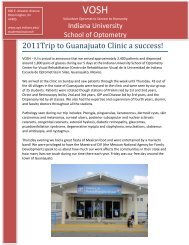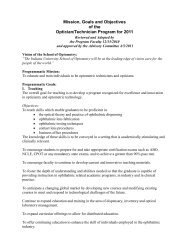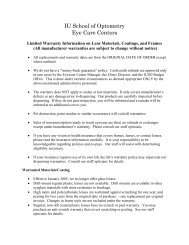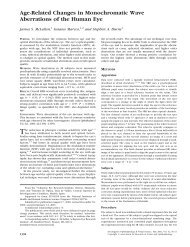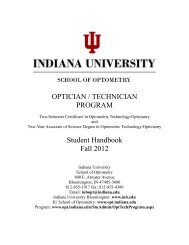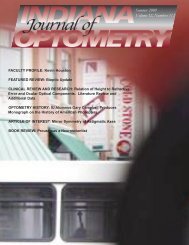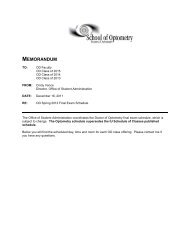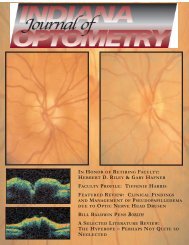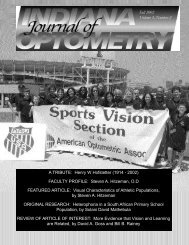Summer 2000 - Indiana University School of Optometry
Summer 2000 - Indiana University School of Optometry
Summer 2000 - Indiana University School of Optometry
You also want an ePaper? Increase the reach of your titles
YUMPU automatically turns print PDFs into web optimized ePapers that Google loves.
Article <strong>of</strong> Interest: Progressive Addition<br />
Lenses for Myopia Control<br />
Review by David A. Goss, O.D., Ph.D.<br />
Leung JTM, Brown B. Progression <strong>of</strong> myopia in Hong Kong Chinese schoolchildren is slowed by wearing<br />
progressive lenses. Optom Vis Sci 1999; 76(6): 346-354.<br />
D<br />
ecades <strong>of</strong> research on childhood myopia<br />
progression still haven’t yielded any<br />
definitive answers on how progression rates<br />
can consistently be controlled. However, it<br />
is widely accepted that nearwork plays a role in<br />
myopia development, as evidenced by the<br />
recent publication <strong>of</strong> two books on the<br />
relationship <strong>of</strong> myopia and nearwork. 1,2<br />
Laboratory studies with animals have shown<br />
that myopia can be induced by the defocus <strong>of</strong><br />
retinal imagery. 3-6 The physiological correlate<br />
in humans to these animal models <strong>of</strong> defocusinduced<br />
myopia may be large lag <strong>of</strong><br />
accommodation during nearwork. Myopic<br />
children and young adults tend to have lower<br />
accommodative response levels than<br />
emmetropes and hyperopes. 1,2,7,8 If defocus<br />
associated with high accommodative lag plays a<br />
role in the etiology <strong>of</strong> human myopia, then the<br />
prescription <strong>of</strong> added plus for near becomes a<br />
logical approach to myopia control.<br />
A recent paper by Leung and Brown 9 reports<br />
progressive addition lenses to have a significant<br />
effect in reducing childhood myopia progression<br />
rates. The study was conducted at The Hong<br />
Kong Polytechnic <strong>University</strong> <strong>Optometry</strong> Clinic<br />
where potential subjects were selected by<br />
review <strong>of</strong> the clinic records. Subject inclusion<br />
criteria were: nine to twelve years <strong>of</strong> age, one to<br />
five diopters <strong>of</strong> myopia, astigmatism less than or<br />
equal to 1.50 D, anisometropia less than or<br />
equal to 1.25 D, intraocular pressure less than<br />
20 mm Hg, monocular visual acuities better than<br />
6/9, stereoacuity better than 100 seconds <strong>of</strong> arc,<br />
and myopia progression greater than -0.4<br />
diopters per year. None <strong>of</strong> the subjects had<br />
strabismus or had a correction for large phorias.<br />
All subjects wore spectacles prior to the study.<br />
Seventy-nine subjects started the study, and 68<br />
completed the full two years <strong>of</strong> the study.<br />
Subjects were examined at six month intervals<br />
during the investigation.<br />
The control group wore single vision spectacle<br />
lenses. There were two progressive addition<br />
lens treatment groups: one with +1.50 D reading<br />
additions and one with +2.00 D reading<br />
additions. Subjects were advised to wear their<br />
glasses full-time. When subjects had a change<br />
in spherical equivalent refraction <strong>of</strong> 0.37 D or<br />
greater, they received new lenses with the new<br />
prescription. The examiner was not masked to<br />
the treatment group or to the previous<br />
prescription.<br />
Study Findings<br />
Refractive error measurements were made by<br />
manifest subjective refraction, and the right eye<br />
spherical equivalent was used for analysis. The<br />
mean increase in myopia in two years for the<br />
single vision lens wearing control group was -<br />
1.23 D (n=32; SD=0.51). The subjects who<br />
wore +1.50 D adds had a mean change in<br />
refractive error <strong>of</strong> -0.76 D (n=22; SD=0.43).<br />
This was significantly different from the mean<br />
change for the control group (p=0.0007). The<br />
subjects with the +2.00 D add treatment had a<br />
mean two year progression <strong>of</strong> myopia equal to -<br />
0.66 D (n=14; SD=0.44). This was also<br />
significantly different from the mean for the<br />
control group (p=0.0007). The means for the<br />
+1.50 D and +2.00 D add groups were not<br />
significantly different (p=0.505).<br />
The depth <strong>of</strong> the vitreous chamber was<br />
measured by ultrasonography. The<br />
enlargement <strong>of</strong> eyes <strong>of</strong> control group subjects<br />
was greater than that for subjects who wore<br />
progressive addition lenses. The mean<br />
increases in vitreous chamber depth were 0.63<br />
mm (SD=0.40) in the single vision lens group,<br />
0.46 mm (SD=0.34) for the +1.50 D add group,<br />
and 0.41 mm (SD=0.41) in the group wearing<br />
+2.00 D adds.<br />
Comments<br />
This appears to be the first published paper<br />
on the use <strong>of</strong> progressive addition lenses for<br />
slowing childhood myopia progression. In the<br />
extensive literature on bifocals for myopia<br />
control, study outcomes have been variable.<br />
One consistent result in four studies is that<br />
mean progression rates were about 0.2 diopters<br />
per year less with bifocals than with single vision<br />
lenses in children with esophoria at near on the<br />
von Graefe test. 10,11 Phorias were not reported<br />
..........................................................<strong>Indiana</strong> Journal <strong>of</strong> <strong>Optometry</strong> ... <strong>Summer</strong> <strong>2000</strong> ... Vol. 3, No. 1... page 17



